Setting and attaining goals is pivotal for personal and professional advancement. The SMART (Specific, Measurable, Achievable, Relevant, Time-Bound) framework proves instrumental for employee success. This article explores the significance of SMART goals for employees, providing real-world examples and offering valuable tips for effective goal-setting.
SMART Goals Unveiled
Discovering the essence of SMART goals is vital for effective goal-setting. The Specific, Measurable, Achievable, Relevant, and Time-Bound components each contribute distinct roles. Specific goals bring clarity to objectives, measurable goals quantify progress, achievable goals set realistic expectations, relevant goals align with broader objectives, and time-bound goals impose deadlines, fostering a sense of urgency and focus.
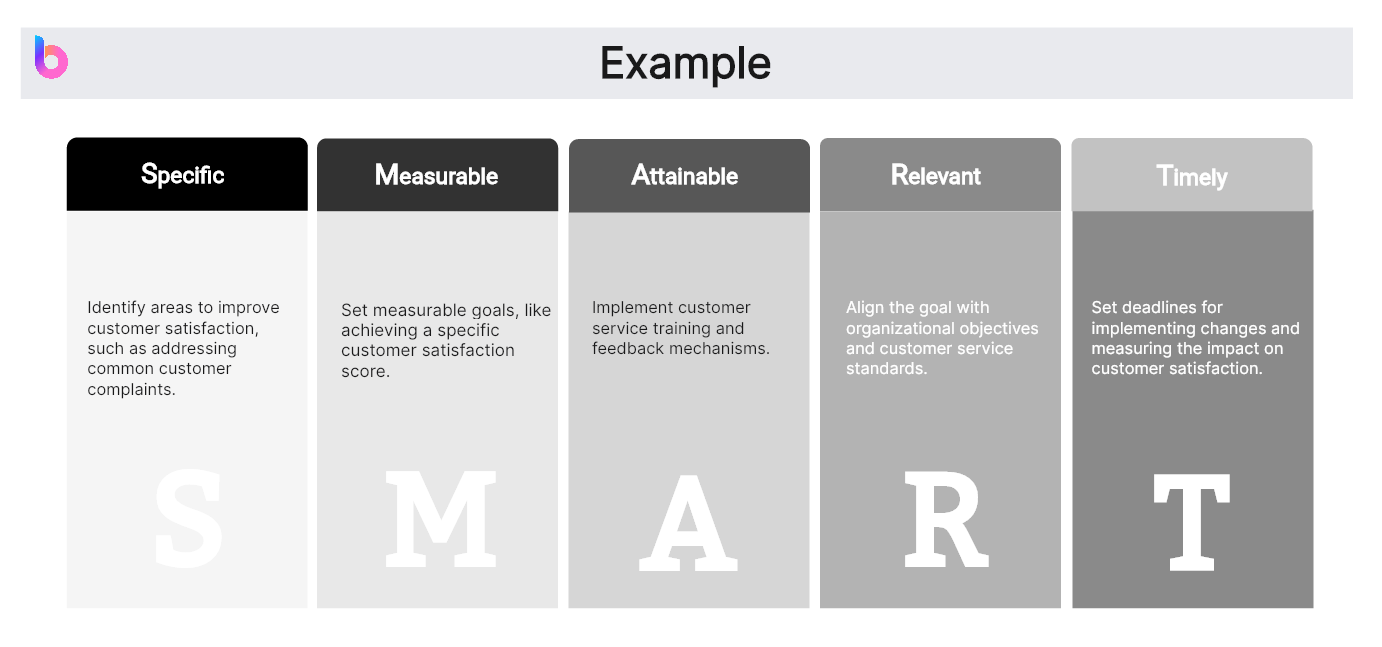
These key components collectively form a powerful strategy for goal-setting, providing individuals with a structured approach to articulate and achieve their objectives. The synergy of these elements ensures that goals are not only well-defined but also realistic, aligning seamlessly with broader organizational objectives. Whether in personal or professional pursuits, the SMART framework serves as a reliable guide for cultivating a results-driven and focused approach to goal attainment.
Why Set SMART Goals for Employees
Setting SMART goals for employees transcends mere protocol; it's a strategic imperative with profound implications for individual and collective achievement. This section illuminates the pivotal role of SMART goals in enhancing performance, fostering motivation, and fortifying communication and expectations within the organizational framework.
Enhanced Performance: Setting SMART goals provides a roadmap for employees, defining clear objectives and expectations. The specificity of these goals allows for a focused approach, leading to improved performance. Employees gain a precise understanding of what is expected, fostering a results-oriented work culture.
Motivational Force: The SMART framework injects a motivational force into the workplace. As employees set and achieve specific, measurable goals, a sense of accomplishment and progress ensues. This positive reinforcement becomes a powerful motivator, driving continuous improvement and sustained effort.
Clear Communication: SMART goals facilitate transparent communication within the organization. With clearly defined objectives, employees and managers share a common understanding of expectations. This clarity minimizes misunderstandings, aligning individual efforts with broader organizational goals.
Expectation Alignment: Aligning individual goals with organizational objectives is a hallmark of SMART goal setting. This alignment ensures that employees contribute meaningfully to the overarching success of the organization. It establishes a cohesive link between individual aspirations and the broader vision, fostering a sense of purpose.
In summary, setting SMART goals for employees is not just a procedural exercise but a strategic initiative with multifaceted benefits. It serves as a catalyst for improved performance, motivation, transparent communication, and alignment of individual efforts with organizational goals, ultimately propelling the entire team towards sustained success.
10 SMART Goals Examples for Employees
In the pursuit of personal and professional growth, setting SMART goals is an indispensable tool for employees. This section unfolds with a detailed exploration of ten SMART goal examples, providing step-by-step guidance for each. By breaking down these examples into specific, measurable, achievable, relevant, and time-bound components, employees can grasp the intricacies of effective goal-setting, fostering a pathway to success.
SMART Goals Example for Employees- 01
Improving Productivity:
- Specific: Identify the aspect of productivity to enhance, such as task completion or project output.
- Measurable: Quantify the improvement, perhaps aiming for a 20% increase in daily output.
- Achievable: Set realistic targets considering current workloads and efficiency levels.
- Relevant: Align the goal with broader team or organizational productivity objectives.
- Time-Bound: Establish a deadline, like achieving the productivity increase within the next two months.

SMART Goals Example for Employees- 02
Enhancing Time Management:
- Specific: Pinpoint specific tasks or activities contributing to time inefficiencies.
- Measurable: Quantify the time spent on each task and set a target for reduction.
- Achievable: Implement strategies such as adopting time management tools or prioritizing tasks.
- Relevant: Ensure time-saving efforts align with overall job responsibilities.
- Time-Bound: Implement changes within a set timeframe, like achieving efficiency improvements within three months.
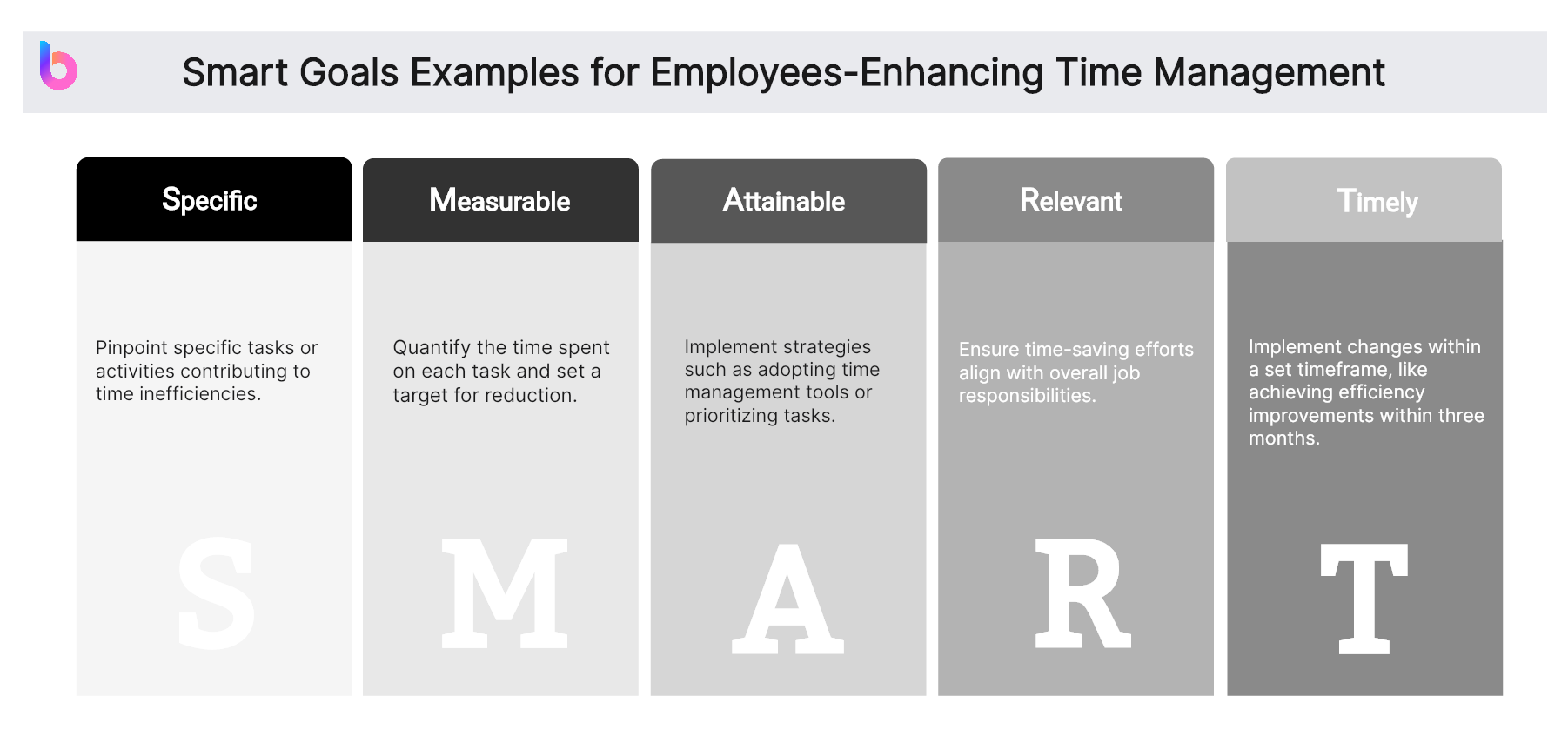
SMART Goals Example for Employees- 03
Skill Development for Career Growth:
- Specific: Identify the skill or certification essential for career advancement.
- Measurable: Clearly define the proficiency level to be achieved, such as mastering advanced coding.
- Achievable: Break down the learning process into manageable steps, focusing on specific modules.
- Relevant: Align the skill development with long-term career goals and the needs of the current role.
- Time-Bound: Set a realistic deadline, like completing the training or obtaining the certification within six months.
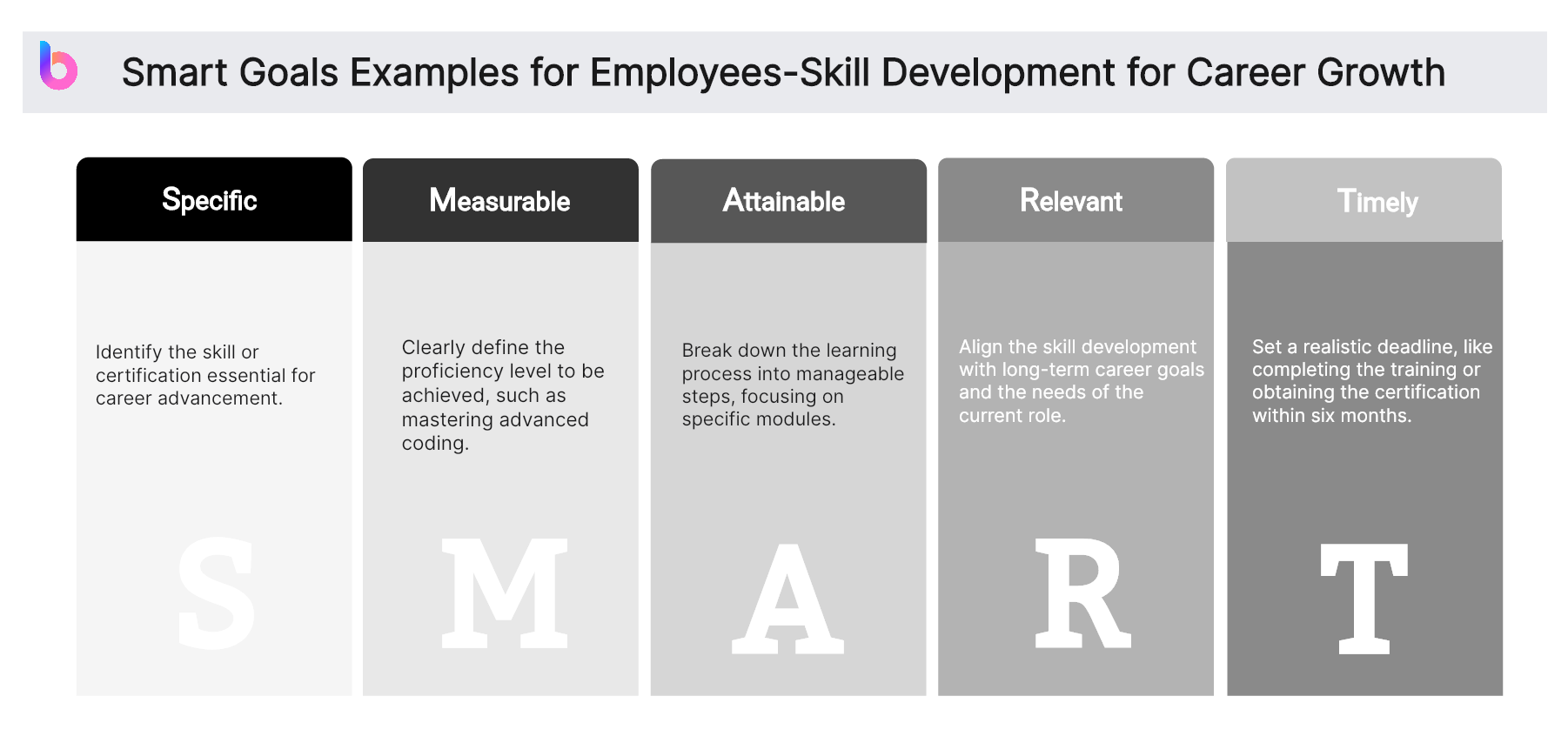
SMART Goals Example for Employees- 04
Mastering Technology or Industry Tools:
- Specific: Specify the technology or tools to master, like becoming proficient in a new project management software.
- Measurable: Set proficiency benchmarks or certifications to achieve, ensuring tangible progress.
- Achievable: Break down the learning process into manageable stages, tackling one aspect at a time.
- Relevant: Ensure mastery aligns with job requirements or industry trends.
- Time-Bound: Set deadlines for achieving proficiency milestones, creating a structured timeline for learning.
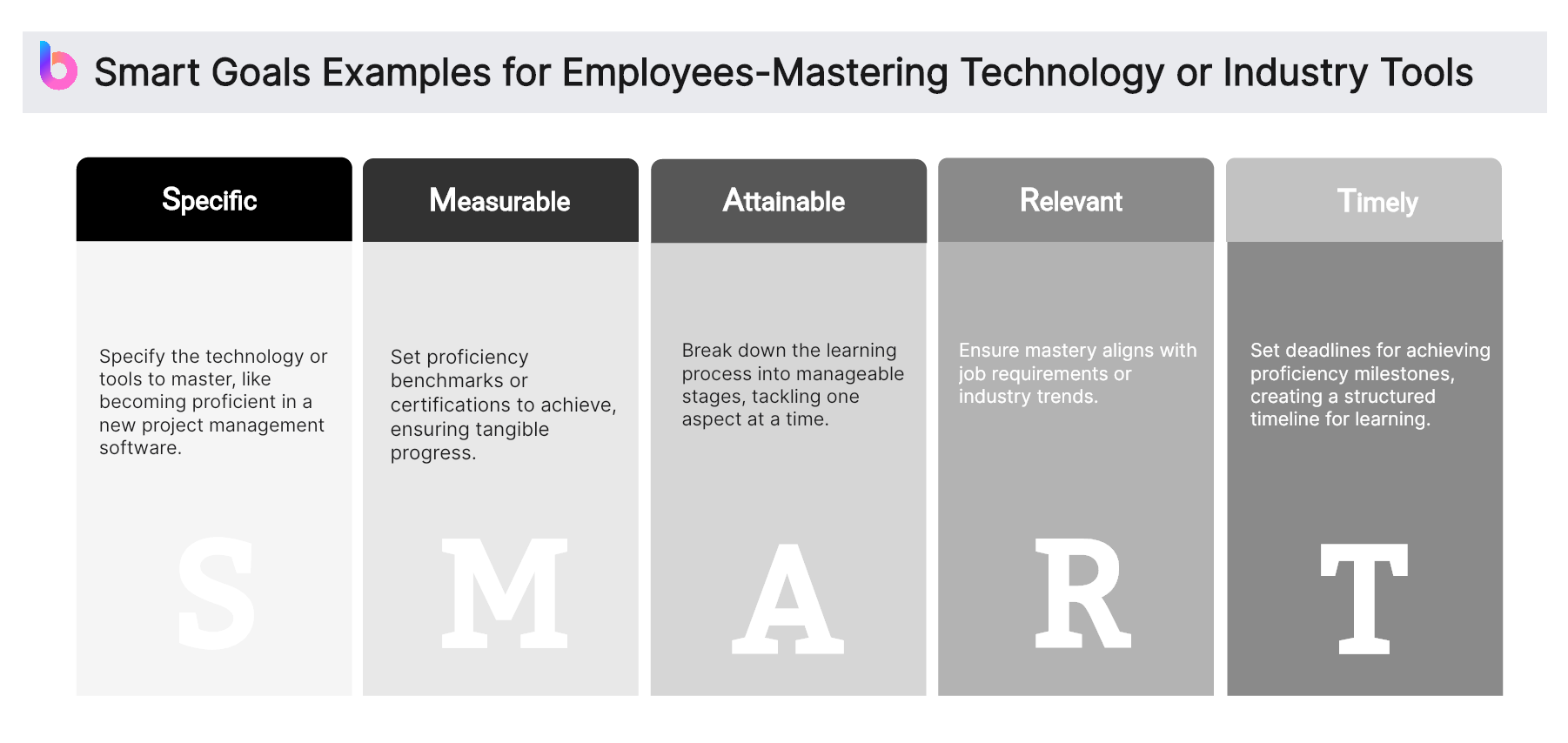
SMART Goals Example for Employees- 05
Pursuing Advanced Training or Certifications:
- Specific: Identify the advanced training or certification relevant to career progression.
- Measurable: Clearly define the proficiency level or knowledge gained through the training.
- Achievable: Break down the training into manageable modules, focusing on key areas.
- Relevant: Align the training with current job responsibilities or future career aspirations.
- Time-Bound: Set a realistic deadline for completing the training or obtaining the certification, ensuring a targeted approach.

SMART Goals Example for Employees- 06
Taking on Leadership Responsibilities:
- Specific: Clearly outline the leadership responsibilities to assume, such as leading a project team.
- Measurable: Define key performance indicators (KPIs) for effective leadership, like team satisfaction or project success.
- Achievable: Identify relevant leadership skills to develop, ensuring a gradual progression.
- Relevant: Align the goal with personal career aspirations and organizational needs.
- Time-Bound: Set a timeframe, such as assuming a leadership role within the next year.
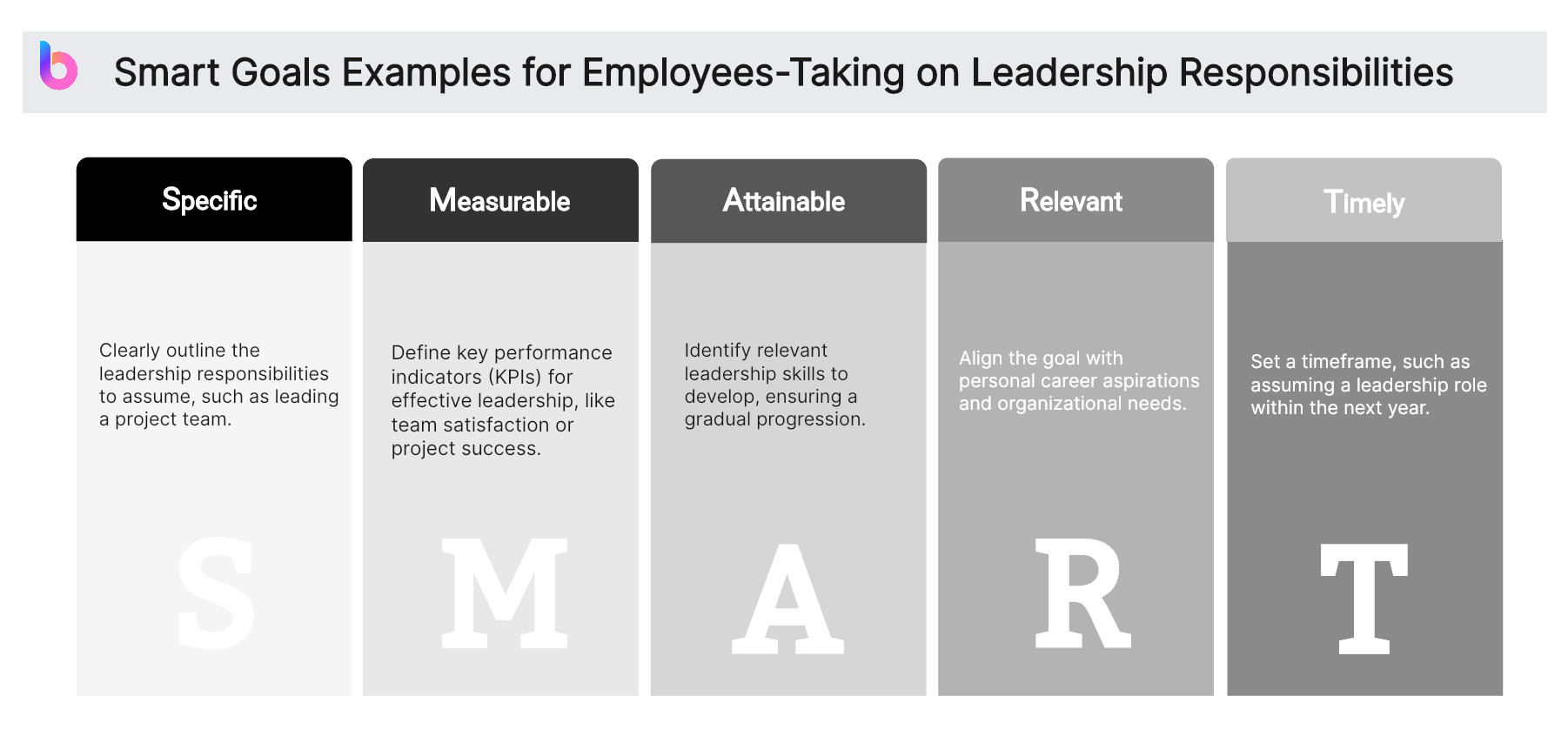
SMART Goals Example for Employees- 07
Increasing Team Collaboration:
- Specific: Define collaboration objectives, like implementing a team-building activity.
- Measurable: Measure collaboration through team surveys or project success metrics.
- Achievable: Implement strategies to foster collaboration, such as regular team meetings or shared platforms.
- Relevant: Ensure enhanced collaboration aligns with team and organizational objectives.
- Time-Bound: Set deadlines for implementing collaboration strategies, promoting a timely improvement.

SMART Goals Example for Employees- 08
Improving Communication Skills:
- Specific: Identify specific communication skills to enhance, such as public speaking or written communication.
- Measurable: Set benchmarks, like delivering a presentation without assistance or crafting clear and concise emails.
- Achievable: Break down skill enhancement into smaller, manageable steps, such as joining a public speaking club or attending writing workshops.
- Relevant: Align skill development with current job responsibilities and future career aspirations.
- Time-Bound: Set a realistic deadline, such as achieving proficiency within six months.
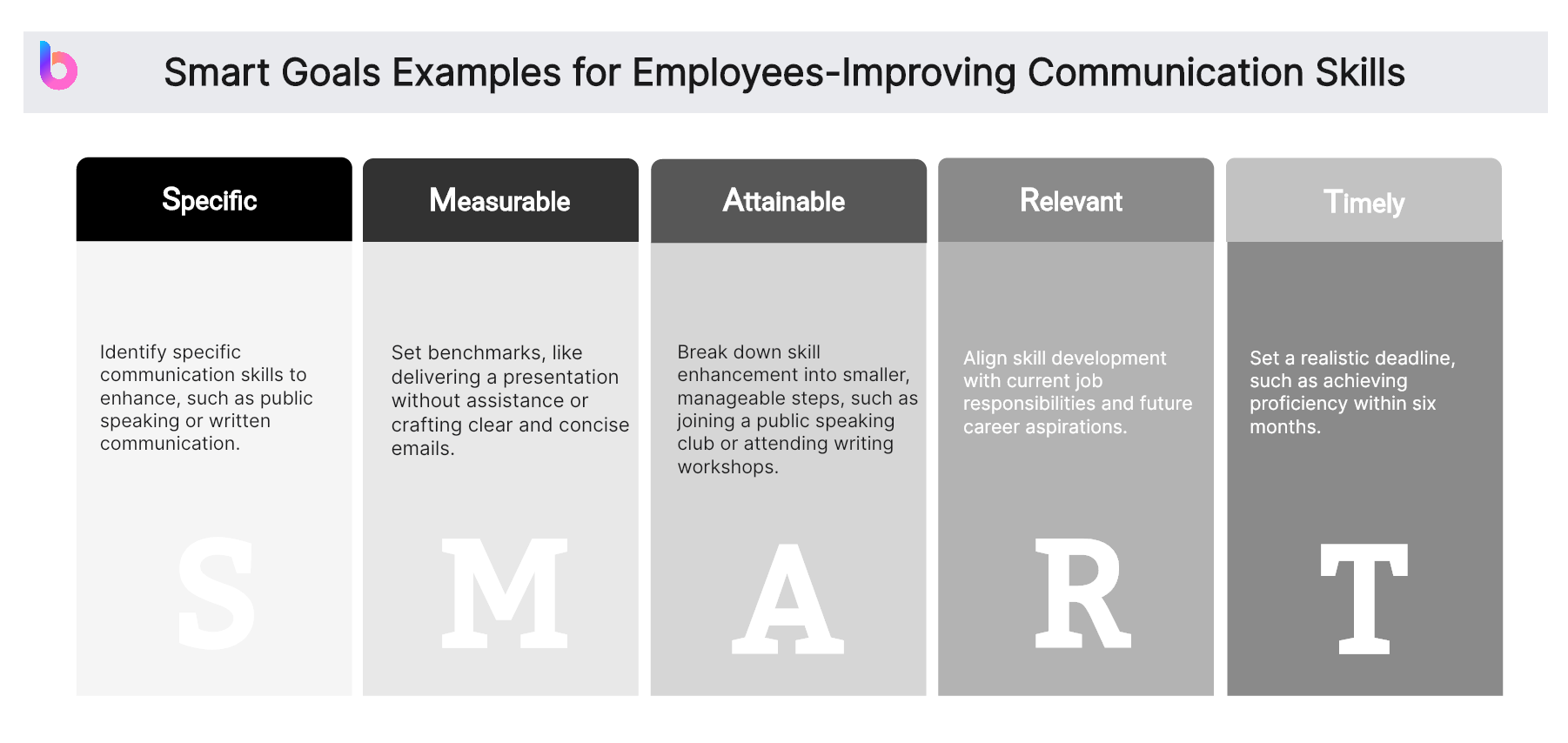
SMART Goals Example for Employees- 09
Balancing Work and Personal Life:
- Specific: Define the aspects of work-life balance to improve, such as reducing overtime hours.
- Measurable: Quantify improvements, like decreasing weekly work hours by a certain percentage.
- Achievable: Implement strategies, such as time-blocking for personal activities or delegating tasks.
- Relevant: Ensure work-life balance aligns with personal well-being and job performance.
- Time-Bound: Set a timeframe, like achieving a better balance within three months.
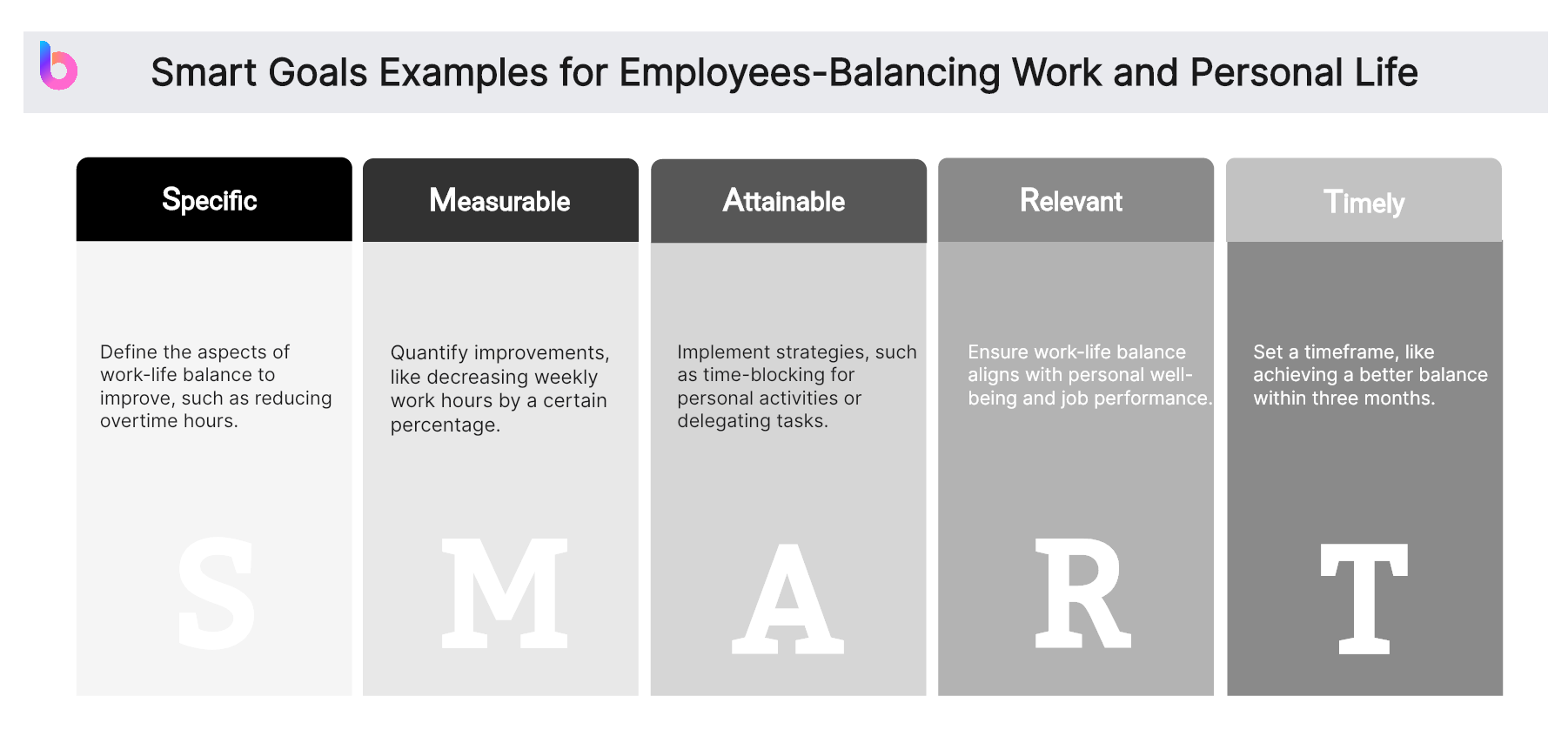
SMART Goals Example for Employees- 10
Enhancing Customer Satisfaction:
- Specific: Identify areas to improve customer satisfaction, such as addressing common customer complaints.
- Measurable: Set measurable goals, like achieving a specific customer satisfaction score.
- Achievable: Implement customer service training and feedback mechanisms.
- Relevant: Align the goal with organizational objectives and customer service standards.
- Time-Bound: Set deadlines for implementing changes and measuring the impact on customer satisfaction.
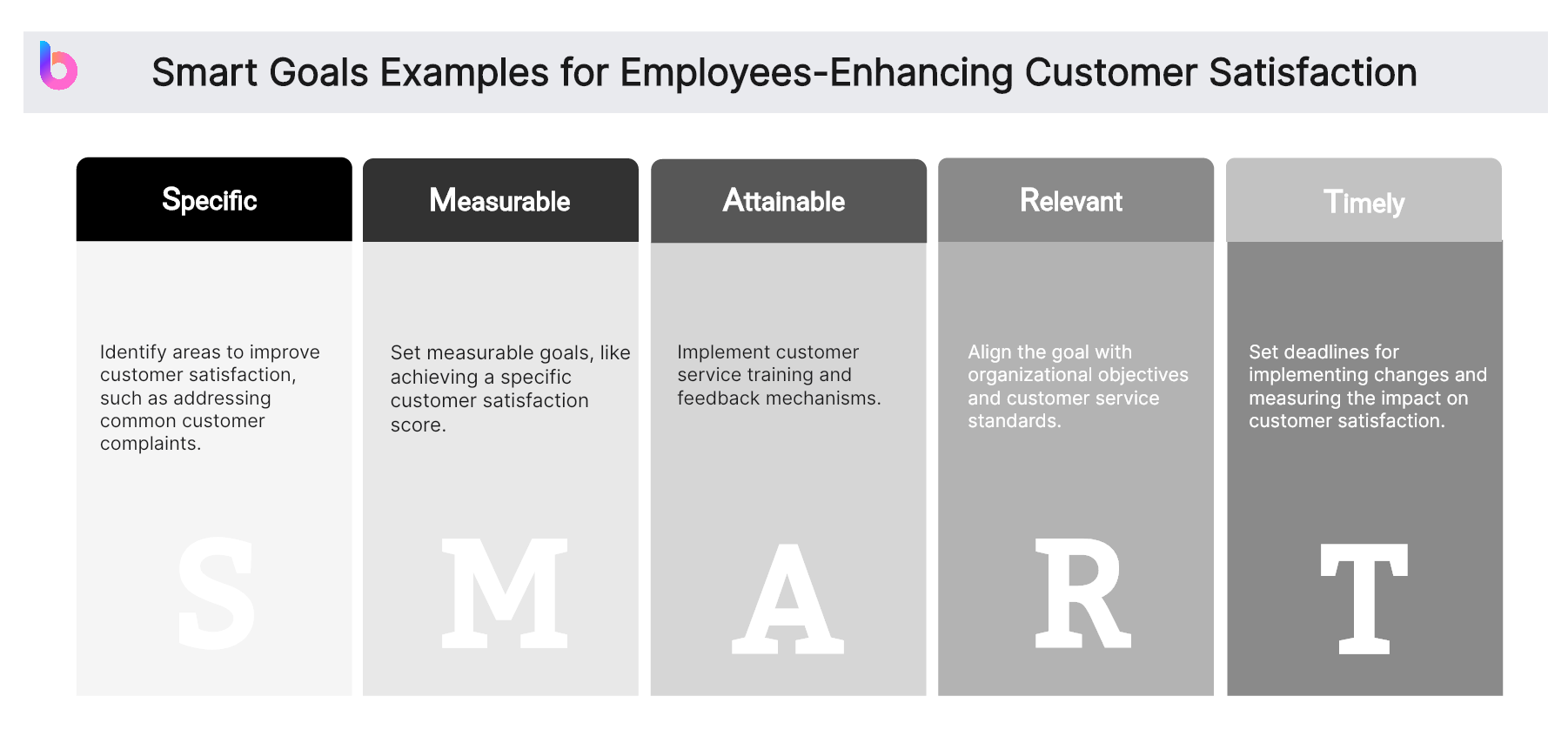
In essence, these ten SMART goal examples illuminate the dynamic nature of effective goal-setting for employees. By embracing specificity, measurability, achievability, relevance, and time-bound attributes, individuals can tailor goals to their unique aspirations. As employees embark on this journey, these step-by-step examples serve as a compass, guiding them towards tangible achievements and sustained growth in both their personal and professional spheres.
Achieving SMART Goals with Boardmix
Every professional recognizes the transformative power of well-articulated goals. They are the backbone of effective work strategies and lay the groundwork for tangible growth in individuals. And while goal-setting is a crucial part of every employee's toolkit, it often poses as an arduous task filled with ambiguity. That's why Boardmix has become such a popular tool!
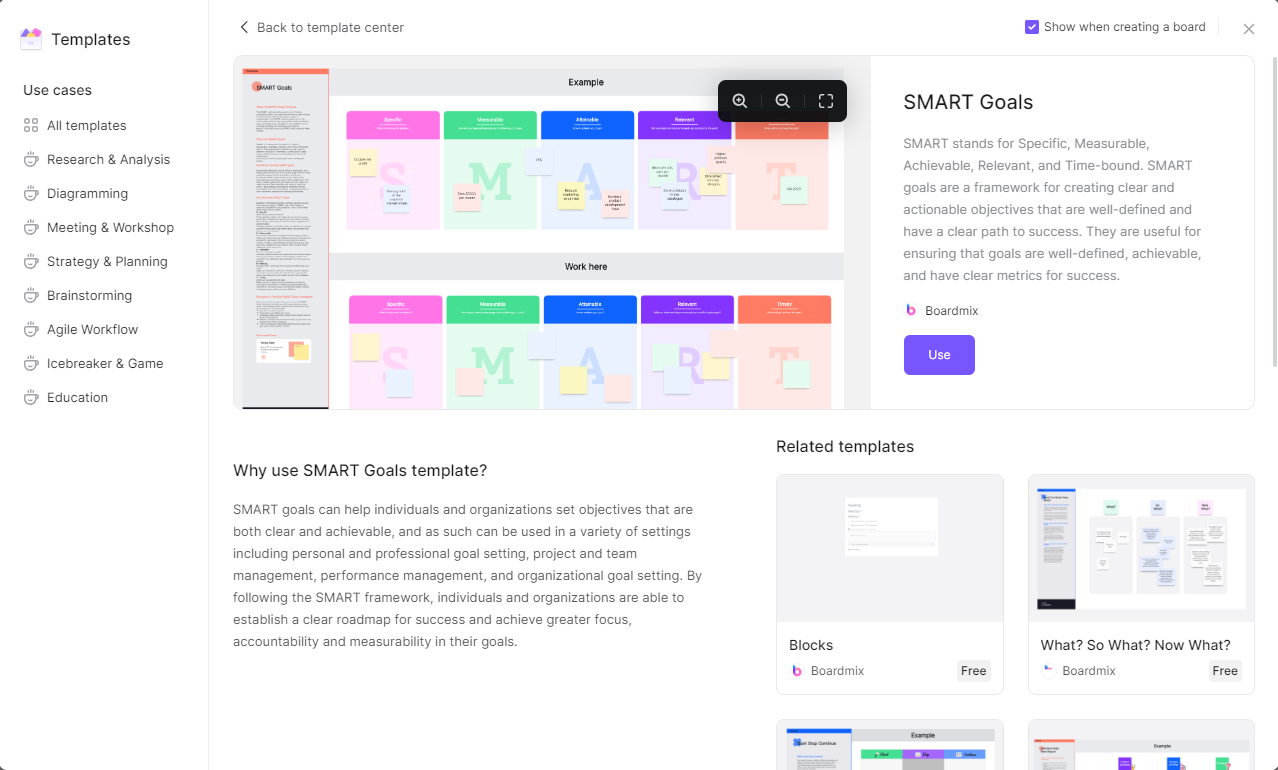
Boardmix is an innovative one-stop solution for creating SMART goals for employees that enhance work methodologies and facilitate optimum individual performance outcomes. At its core, Boardmix allows employees to convert their broad objectives into Specific, Measurable, Achievable, Relevant, and Time-bound goals. This platform equips individuals with a user-friendly interface, efficient tools, and a supportive community to turn abstract career aspirations into well-defined, actionable targets.
The platform's functionality hinges on four key features:
- Guided Interface: A structured yet flexible user interface that walks employees through each step of formulating a SMART goal example.
- Ready-made Templates: A wide range of ready-made templates can be used directly by employees to set their SMART goals quickly and easily.
- Task Management: With Boardmix's management tools, employees can track their progress towards achieving the goal over time. This not only promotes accountability but also provides a chance to recalibrate strategies if needed.
- Share and Learn: Finally, Boardmix facilitates knowledge exchange by encouraging users to share their SMART goals journey within its community of professionals. This step nurtures professional growth through shared learning experiences.
Boardmix revolutionizes SMART goal creation for employees by providing an easy-to-use, comprehensive platform that not only simplifies the process but also ensures individuals gain maximum value from their goals. So whether you are a new employee or a seasoned professional looking to make your work more targeted and effective, Boardmix is your perfect companion in the journey towards professional excellence.
Tips and Tricks on Setting SMART Goals for Employees
Setting SMART goals is just the beginning; sustained success requires ongoing effort. This section provides essential tips and tricks to guide employees through the entire journey, ensuring that SMART goals are not only established but also successfully achieved.
Regular Check-ins: Regularly reviewing progress is crucial. Schedule check-ins to assess how well goals align with expectations and adjust strategies if necessary. This proactive approach keeps employees on track and engaged.
Collaborative Strategies: Foster a collaborative environment where team members can share insights and strategies. Collaborative problem-solving enhances goal attainment, as diverse perspectives contribute to well-rounded solutions.
Adaptive Goal Adjustments: Flexibility is key. If circumstances change or new opportunities arise, be open to adjusting goals accordingly. Adaptability ensures that goals remain relevant and achievable in dynamic work environments.
Celebrate Achievements: Acknowledge and celebrate milestones. Recognizing accomplishments, no matter how small, boosts morale and motivates employees to persist in their SMART goal pursuit. It also reinforces the positive impact of their efforts.
Learn from Setbacks: Setbacks are a natural part of any journey. Encourage employees to view setbacks as opportunities for learning and growth. Analyzing challenges helps refine strategies, making future SMART goals even more attainable.
Clear Communication: Maintain open lines of communication. Employees should feel comfortable discussing their goals, progress, and challenges with supervisors and team members. Clear communication fosters a supportive environment for goal achievement.
Visual Progress Tracking: Create visual representations of progress. Whether through charts, graphs, or project management tools, visual tracking provides a tangible representation of accomplishments, motivating employees to persist.
Continuous Learning: Encourage a culture of continuous learning. SMART goals are not static; they evolve as employees grow and develop. Promote ongoing skill development and knowledge enhancement to align with changing objectives.
By incorporating these tips and tricks into the SMART goal-setting process, employees can navigate the path to success with resilience and efficiency. The journey becomes not just about reaching the destination but about continual growth, adaptability, and the collective pursuit of excellence within the workplace.









